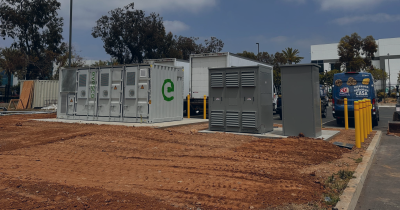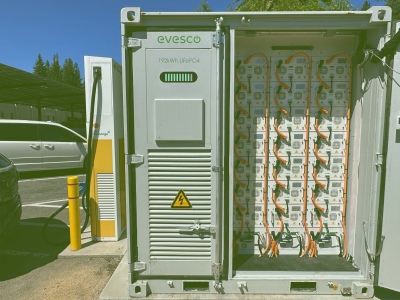How Long Does it Take to Charge an Electric Vehicle (EV)?
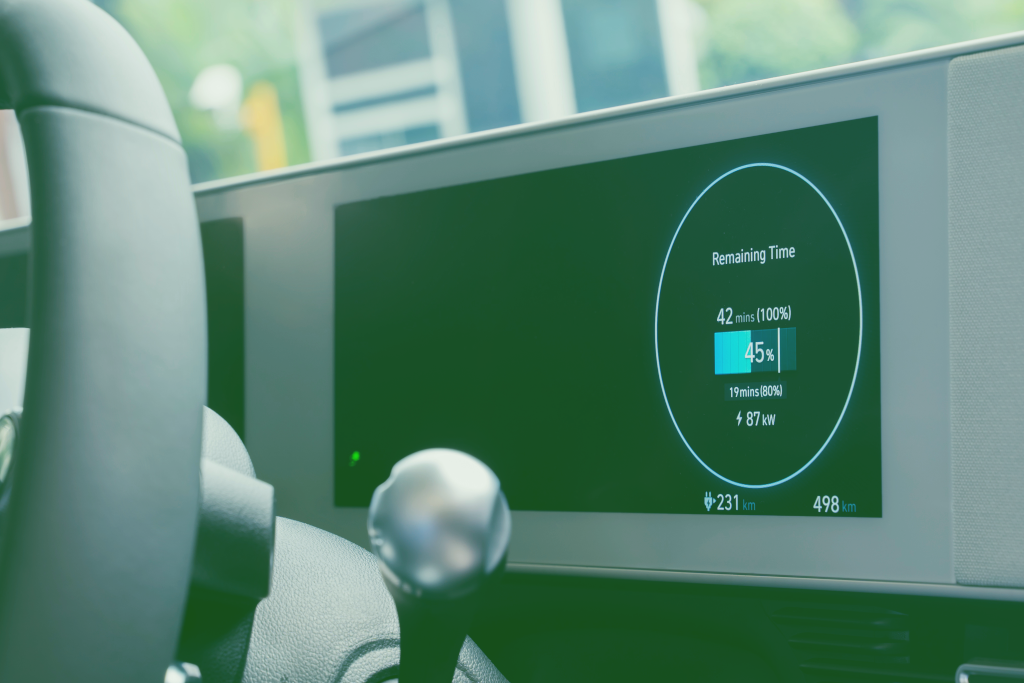
As the shift towards sustainable transportation continues accelerating, electric vehicles (EVs) are becoming increasingly popular for drivers looking for their next car. Understanding EV charging, particularly charging times, is crucial. This knowledge helps in everyday use and planning longer journeys. It also answers one of potential buyers’ main questions: How long does it take to charge an electric vehicle?
The demand for EVs is growing worldwide. Recent industry reports show that by 2030, almost 1 in 5 cars on the road, both in the United States and the European Union, will be electric, indicating the increasing acceptance of electric vehicles in these markets. Substantial improvements in battery technology and charging speeds underpin this growth. Modern EVs now boast batteries with higher voltages and more energy density, supporting faster charging capabilities and reducing the time it takes to charge an electric car.
Understanding the factors that affect how long it takes to charge an electric vehicle is vital to owning one. This article explores these aspects, offering insights into what electric car owners and potential buyers can expect regarding EV charging times.
Factors That Influence EV Charging Time
EV charging time varies based on several key factors, which drivers should understand to plan effectively.
Battery Size: Larger batteries store more energy and take longer to charge. A 100 kWh battery charges slower than a 30 kWh battery under the same conditions.
Battery Architecture (Voltage Systems): Higher-voltage systems, like 800 V architectures in some Tesla and Porsche models, can handle faster charging than 400 V systems, significantly reducing charge times.
State of Charge (SOC): Batteries charge fastest when low and slow as they near full capacity. DC fast chargers are most efficient between 20%–60% SOC; charging slows near 80%–100% to protect the battery.
Maximum Vehicle Charging Rate: Each EV has a limit on how much power it can accept, which may be lower than the charger’s output. Onboard hardware and battery management determine this rate for AC and DC charging.
Charging Station Power Output: Even if an EV can handle high power, the station’s output determines actual charging speed. Station levels (AC Level 1–3, DC fast charging) directly affect how quickly an EV charges.
Environmental Factors: Extreme temperatures reduce charging efficiency. Cold conditions require preheating, while hot conditions trigger cooling systems, both slowing charge rates.
Understanding battery specs, vehicle limits, charger power, and environmental conditions helps drivers plan charging sessions efficiently and choose the right EV and infrastructure for their needs.
Comparing Charging Times for Levels 1, 2, and 3
Categorized into three levels, each EV charging level offers different power outputs, directly affecting how long it takes to charge an electric car at a charging station. Here’s an overview of each level, including its typical EV charging times and range gained per hour of charging. These charging times are based on the average usable energy of an electric car battery of 71 kWh and the average energy consumption of 300 Wh per mile.
Level 1 Charging Time
These EV chargers utilize a standard domestic AC socket. They can provide a power output of up to 1.8 kW in the US and up to 2.3 kW in Europe.
- Charging Time: This is the slowest charging option available, generally adding about 6 to 7 miles (9 -11 kilometres) of range per hour of charging. Charging the average-sized electric car battery from zero to full can take between 40 and 71 hours.
Level 1 EV chargers are impractical due to their low charging speeds. EV owners with minimal daily mileage typically use these chargers at home as a backup or for long-duration charging.
Level 2 Charging Time
This level of EV charging is much faster than Level 1. It utilizes a 208/240V AC connection in the US, enabling a 19.2 kW EV charger. In Europe, it uses a 230V (single-phase) or 400V (three-phase) connection, delivering up to 22 kW.
- Charging Time: Level 2 chargers speed up the time to charge an electric car, offering about 10 to 73 miles (16 – 117 kilometres) of range per hour, depending on the power output and vehicle compatibility. With this charging level, the average electric car battery would take 4 to 24 hours to charge fully.
Level 2 EV chargers are suitable for residential, workplace, and other public locations such as hotels, retail parks, and supermarkets, where longer-duration parking is standard.
Both Level 1 and Level 2 charging delivers alternating current (AC) to electric vehicles, converted to direct current (DC) via an onboard charger before going to the battery.
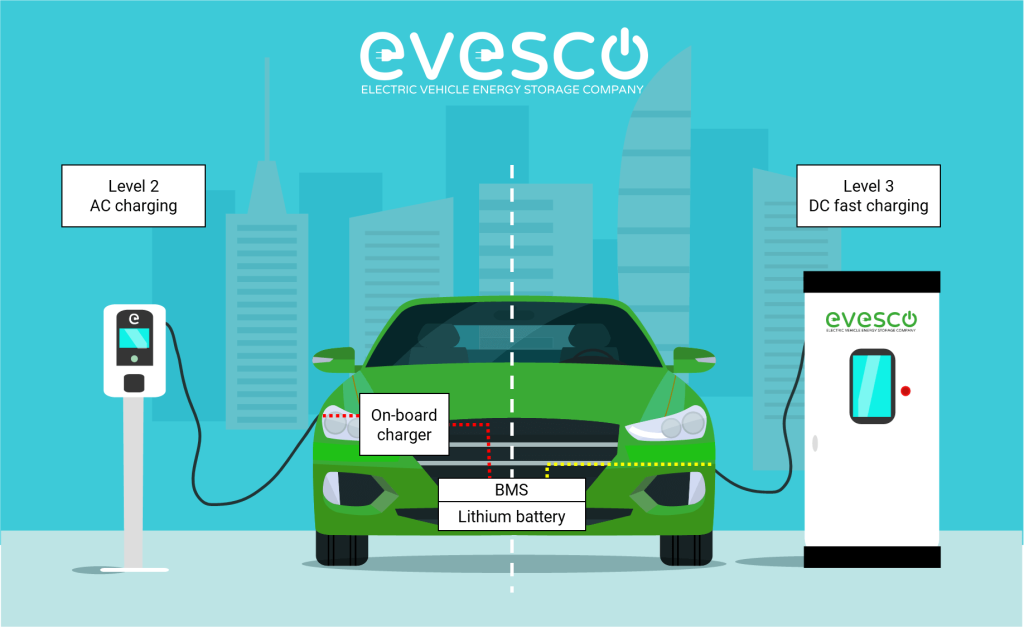
Level 3 Charging Time
Level 3 charging, also known as DC fast charging (DCFC), delivers DC instead of AC. This type of EV charging bypasses the car’s onboard charger, providing power directly to the battery for much faster charging times. These charging stations utilize a three-phase input and can output power from 30 kW to over 360 kW.
- Charging Time: DCFC is the fastest charging option available. It can fully charge some electric cars in under 20 minutes and deliver about 100 to 1200 miles of range per hour of charging.
DCFC is crucial for reducing downtime during long-distance travel. It is found primarily along highways and in urban areas where quick recharging is necessary.
The EV range chart below indicates how much range can potentially be added to an an electric vehicle per hour of charging using different level charging stations.
| Level 1 | Level 1 | Level 2 | Level 2 | Level 2 | Level 2 | Level 2 | Level 2 | DCFC | DCFC | DCFC | DCFC | DCFC | DCFC | |
| 1.8 kW | 2.3 kW | 3.7 kW | 7.6 kW | 9.6 kW | 11 kW | 19.2 kW | 22 kW | 30 kW | 60 kW | 120 kW | 150 kW | 180 kW | 360 kW | |
| Miles (up to) | 6 | 7 | 12 | 25 | 32 | 36 | 64 | 73 | 100 | 200 | 400 | 500 | 600 | 1200 |
| Kilometres (up to) | 9 | 11 | 19 | 40 | 51 | 57 | 102 | 117 | 160 | 321 | 643 | 804 | 965 | 1930 |
These range per hour figures are estimates only and are based on the average energy consumption of an electric car of 300 Wh per mile. Range per hour can vary greatly depending on the efficiency of the vehicle, how it is driven, how full the battery is, and the charging curve.
Estimating Charge Time For Electric Vehicles
The basic formula to calculate the estimated charging time for an electric vehicle is:
Charging time (hours)= Battery capacity (kWh) – Remaining battery capacity / Charging power (kW) or Charge acceptance rate of vehicle (kW), whichever is lower. See the illustration below.
This formula estimates how long it takes to charge an EV with an AC charger. See the illustration below.
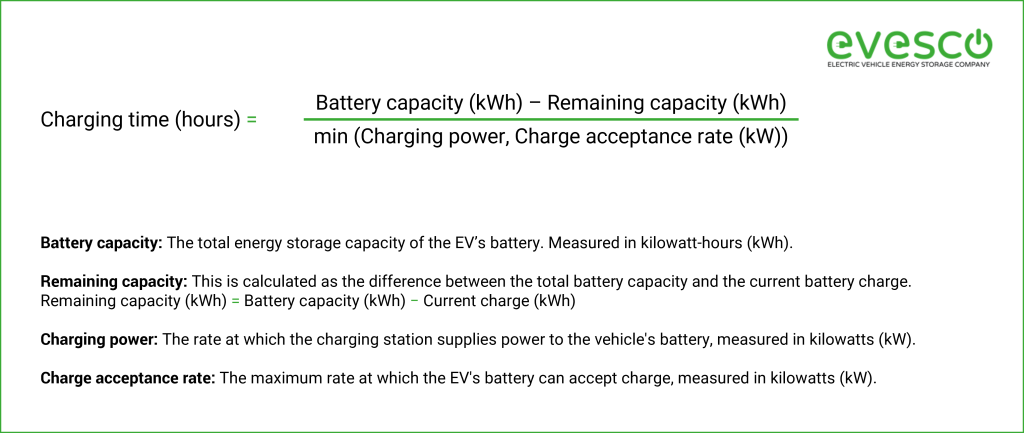
Step-by-Step Calculation:
- Determine Battery Capacity: Your EV’s battery’s total energy storage capacity is listed in kWh. For instance, if your EV’s battery capacity is 80 kWh, you’ll use this figure.
- Assess Current Battery State of Charge: Check how much charge your battery has. This information is accessible on your in-vehicle display. If your battery is 50% charged and the total capacity is 80 kWh, the current charge is 40 kWh. Thus, you need to top up 40 kWh to reach full charge.
- Charger Power Output: This is the maximum rate at which the charging station can deliver power to your EV, which is measured in kW.
- Vehicle Charge Acceptance Rate: This is the maximum power in kW that the vehicle’s battery can input from an AC or a DC charger. The DC charge acceptance rate will be much higher than the AC acceptance rate.
- Calculate Charging Time: Subtract the current battery state of charge from the total capacity to find out how much energy is needed. Then, divide this number by the power output of your charger or the vehicle’s charge acceptance rate, whichever is lowest.
Example Calculations for EV Charging Times
AC Charging: An EV with an 80 kWh battery, 50% charged, 11 kW charge acceptance rate, using a 7.6 kW Level 2 charger:
- Charge needed = 80 kWh−40 kWh = 40 kWh
- Charging Time = 40 kWh / 7.6 kW = 5.26 hours
In this example, we have used the charger’s maximum output power, which is lower than the electric vehicle’s charge acceptance rate.
Considering the Tapering Effect
The tapering effect is especially relevant for DC fast charging. As the battery approaches full charge, the charging speed will decrease to protect the battery’s life and health. This tapering means the last 20% of the battery might charge slower than the first 80%.
The diagram below shows AC charging (Levels 1 and 2) and DC fast charging (Level 3) curves and how they differ. You will notice the tapering.
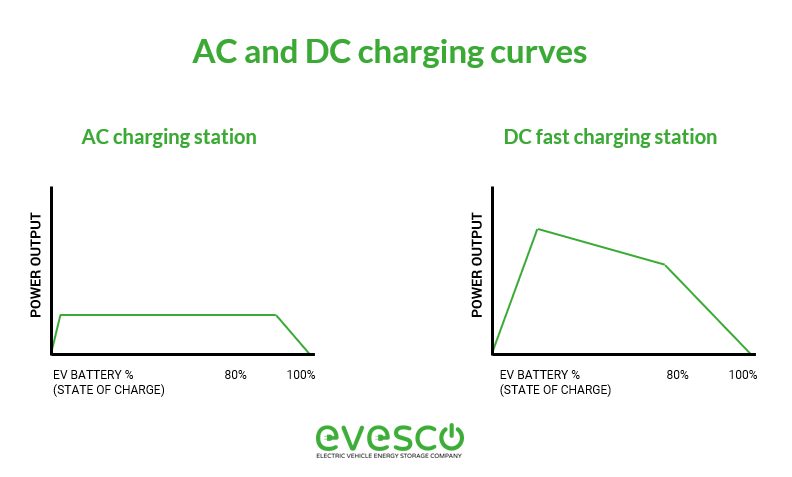
Each electric vehicle has a unique charging curve that dictates how long it takes to charge. This means you could have two electric cars with the same DC charge acceptance rate, but when they are plugged into a charging station, they both charge differently based on their unique charging curve.
These unique charging curves make it difficult to estimate how long it takes to charge an electric vehicle with a DC fast charging station. An electric vehicle’s average charge rate, when charging between 10% and 80%, can vary between 40% and 90% of the vehicle’s maximum charge acceptance rate. The table below shows examples of electric cars’ maximum charge acceptance rates compared to their average charge rate.
| Model | Maximum Charge Acceptance Rate | Average Charging Power (10% – 80%) | Percentage of |
| Tesla Model 3 | 170 kW | 100 kW | 59% |
| BYD ATTO 3 | 89 kW | 73 kW | 82% |
| MG 4 | 142 kW | 116 kW | 82% |
| Lotus Emeya S | 350 kW | 240 kW | 69% |
| Porsche Taycan Plus | 320 kW | 230 kW | 72% |
| Mini Aceman SE | 95 kW | 76 kW | 80% |
| Ford Mustang Mach-E | 150 kW | 95 kW | 63% |
| Hyundai IONIQ 6 | 175 kW | 140 kW | 80% |
| Volkswagen ID Buzz GTX | 185 kW | 130 kW | 70% |
| Genesis GV60 Premium | 233 kW | 200 kW | 86% |
As you can see from the table above, each electric vehicle’s charging time will differ based on its unique charging curve; this makes the previous formula not applicable for DC fast charging. You will need to review the specifications for the specific electric vehicle to understand the charging time when using a DC fast charger.
Electric Car Charging Time
Below, we have created a table of the best-selling electric cars, detailing their battery size, charge acceptance rates, and estimated charging time. This table will show estimates of how long it takes to charge popular electric cars.
| Battery Size (usable) | AC Charge Acceptance Rate | Estimated AC Charge Time 0% – 100% | DC Charge Acceptance Rate (maximum) | Average DC Charge Rate 10% – 80% | Estimated DC Charge Time 10% – 80% | |
| Tesla Model Y (RWD) | 68 kWh | 11 kW | 6 hours 12 mins | 170 kW | 100 kW | 29 minutes |
| Tesla Model 3 (RWD) | 68 kWh | 11 kW | 6 hours 12 mins | 170 kW | 100 kW | 29 minutes |
| Volkswagen ID 4 (GTX) | 77 kWh | 11 kW | 7 hours | 175 kW | 120 kW | 27 minutes |
| MG 4 | 51 kWh | 6.6 kW | 7 hours 42 mins | 87 kW | 68 kW | 32 minutes |
| Skoda Enyaq (60) | 58 kWh | 11 kW | 5 hours 18 mins | 124 kW | 82 kW | 30 minutes |
| Fiat 500 | 21.3 kWh | 11 kW | 1 hour 54 mins | 50 kW | 40 kW | 23 minutes |
| Volkswagen ID 3 (Pro) | 58 kWh | 11 kW | 5 hours 18 mins | 120 kW | 80 kW | 31 minutes |
| Dacia Spring (45) | 25 kWh | 6.6 kW | 3 hours 48 mins | 34 kW | 29 kW | 37 minutes |
| BMW i4 (eDrive35) | 67 kWh | 11 kW | 6 hours 6 mins | 180 kW | 95 kW | 30 minutes |
| Audi Q4 (e-tron 45 Quattro) | 77 kWh | 11 kW | 7 hours | 175 kW | 120 kW | 27 minutes |
These charging times are estimated based on assumptions intended only for general comparison. Actual charging times depend on several factors, including the vehicle’s charging capability, usable battery capacity, energy losses, current state of charge, charger output, and environmental conditions. Understanding how to estimate how long it takes to charge an electric vehicle and the factors that affect it helps current and prospective EV owners manage their charging expectations and make informed decisions about electric cars and charging infrastructure.

